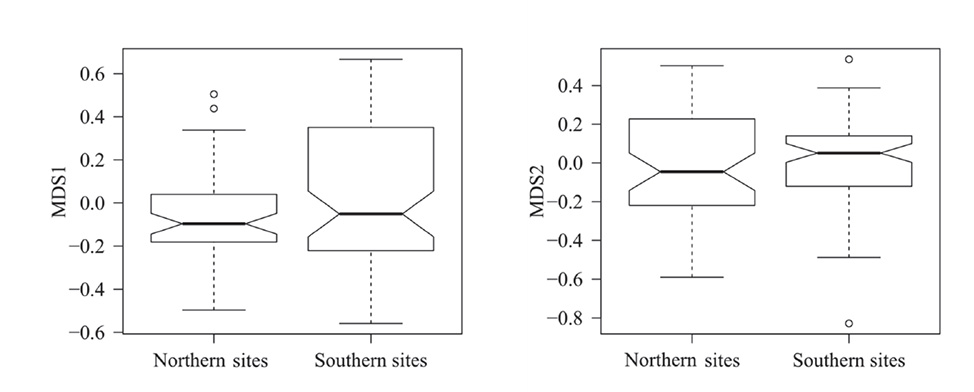
Ecological Archives E096-047-A2
Katie E. Marshall and Jennifer L. Baltzer. 2015. Decreased competitive interaction drive a reverse species richness latitudinal gradient in subarctic forests. Ecology 96:461–470. http://dx.doi.org/10.1890/14-0717.1
Appendix B. Statistical results of geographic distance and community structure analyses with plots of MDS scores.
Geographic and community distance
There was no significant difference in geographical distances between northern and southern sites (F1, 3779 = 0.021, p = 0.884). Mantel tests showed no significant distance-decay in community composition in the south (Mantel statistic r = -0.044, p =0.875), but significant decay in the north (Mantel statistic r = 0.098, p = 0.0209). Regression of the community distances and geographical distances in the north showed a small, but positive relationship between community distance and geographical distance (1.913 × 10-7).
Community structure
There was no difference in mean MDS scores on either the first or second dimension between northern and southern sites (p > 0.05 in both cases, Fig. B1). Fisher tests showed that variability in MDS1 score was higher in the south than in the north (F49, 71 = 0.371, p < 0.001), while there was no difference in variability in MDS2 (F49, 71 = 1.57, p = 0.080). When MDS scores were plotted spatially, there was no apparent spatial clustering to MDS scores (Fig. B2). Finally, distance between MDS scores was significantly higher in the southern sites than in the northern sites (F1, 3779 = 61.55, p < 0.001).
Fig. B1. MDS scores from nonmetric multidimensional scaling presented in Fig. 4.
Fig. B2. MDS scores from nonmetric multidimensional scaling plotted as a function of spatial position.
Fig. B3. Frequency distributions of MDS scores.